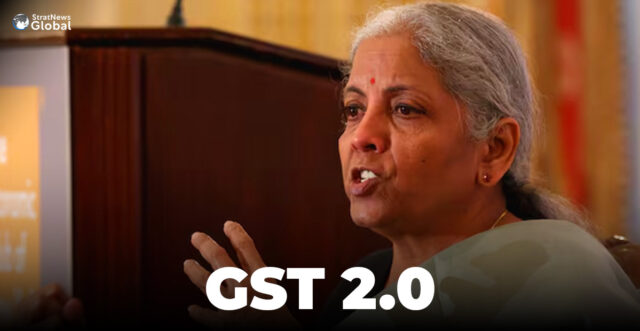India has slashed Goods and Services Tax (GST) rates across a wide spectrum of consumer goods—from soaps to compact cars—in an effort to stimulate demand in the world’s fourth-largest economy as it grapples with mounting pressure from U.S. tariffs.
The GST Council, chaired by Union Finance Minister Nirmala Sitharaman, overhauled the indirect tax structure by trimming it down from four tiers—5%, 12%, 18% and 28%—to a simplified two-tier system of 5% and 18%. Alongside this change, a special 40% slab has been introduced for sin products and high-end luxury items.
The revised rates will take effect on September 22, coinciding with the start of the Navratri festival season.
‘Major Reform’
“This reform is not confined to just rate rationalisation. It is also about structural improvement, about the ease of living, and about simplifying how businesses engage with GST,” Sitharaman declared at a press briefing late Wednesday.
She emphasised that, “slabs have been reduced to only two, and we are reviewing issues related to the compensation cess.”
Sitharaman added that the changes were made with ordinary citizens in mind, noting that most daily-use items have seen substantial reductions in GST.
The finance minister further highlighted that labour-heavy sectors, along with agriculture and healthcare, would gain from the reforms.
She said that distortions in the duty structure had been corrected, classification disputes resolved, and stability brought into the GST regime.
Modi Hails GST Cut
Prime Minister Narendra Modi had first flagged the plan to reduce GST in his Independence Day address on August 15.
After Wednesday’s announcement, he hailed the Council’s decisions, saying the reforms would “enhance the lives of citizens and ensure ease of business, particularly for small traders and enterprises.”
Among the biggest beneficiaries are small cars, a segment vital to India’s automotive market.
Cars under four metres in length with petrol engines up to 1,200 cc and diesel engines up to 1,500 cc will now be taxed at 18%, down from the previous 28%. Anything larger or more powerful will attract the new 40% slab.
Motorcycles also see a significant shift. Two-wheelers with engines up to 350 cc will now be taxed at 18%, compared with the earlier 28%, while heavier bikes move into the 40% bracket.
The steep 40% GST slab has been reserved primarily for sin goods and a limited set of luxury products, according to a Council statement.
It applies to tobacco, luxury automobiles, high-end motorcycles, aerated drinks with added sugar or flavouring, caffeinated beverages, and other non-alcoholic drinks.
However, its application to tobacco will be delayed due to unresolved technicalities linked to outstanding loans.
Compensation Cess-GST Merger
The merging of the compensation cess with GST was also clarified in Council FAQs: “Since the compensation cess is being discontinued, the levy has been integrated into GST to preserve the tax incidence on most items. For goods that were already under the highest 28% slab, a special rate is now being imposed.”
Insurance has also been addressed under the reforms. All individual health insurance policies—including senior citizen and family floater plans—will now be exempt, as will individual life insurance.
Additionally, 33 critical drugs, including those for cancer and rare diseases, have been freed from GST.
Affordable Homes
Construction materials such as cement have also seen their rates cut to 18% from 28%, a change expected to provide immediate relief to the real estate sector.
Experts note that affordable housing stands to gain the most, since lower input costs could translate into more accessible prices for homebuyers and further the government’s Housing for All initiative.
The overall fiscal cost of the GST rationalisation is projected at ₹48,000 crore annually, Revenue Secretary Arvind Shrivastava stated.
However, he argued that this burden may be offset by stronger consumer demand and higher compliance.
“The rationalisation will likely have a buoyancy effect, improving consumer sentiment and encouraging spending. We also expect better compliance as the system becomes more predictable,” Shrivastava explained.
(With inputs from IBNS)





